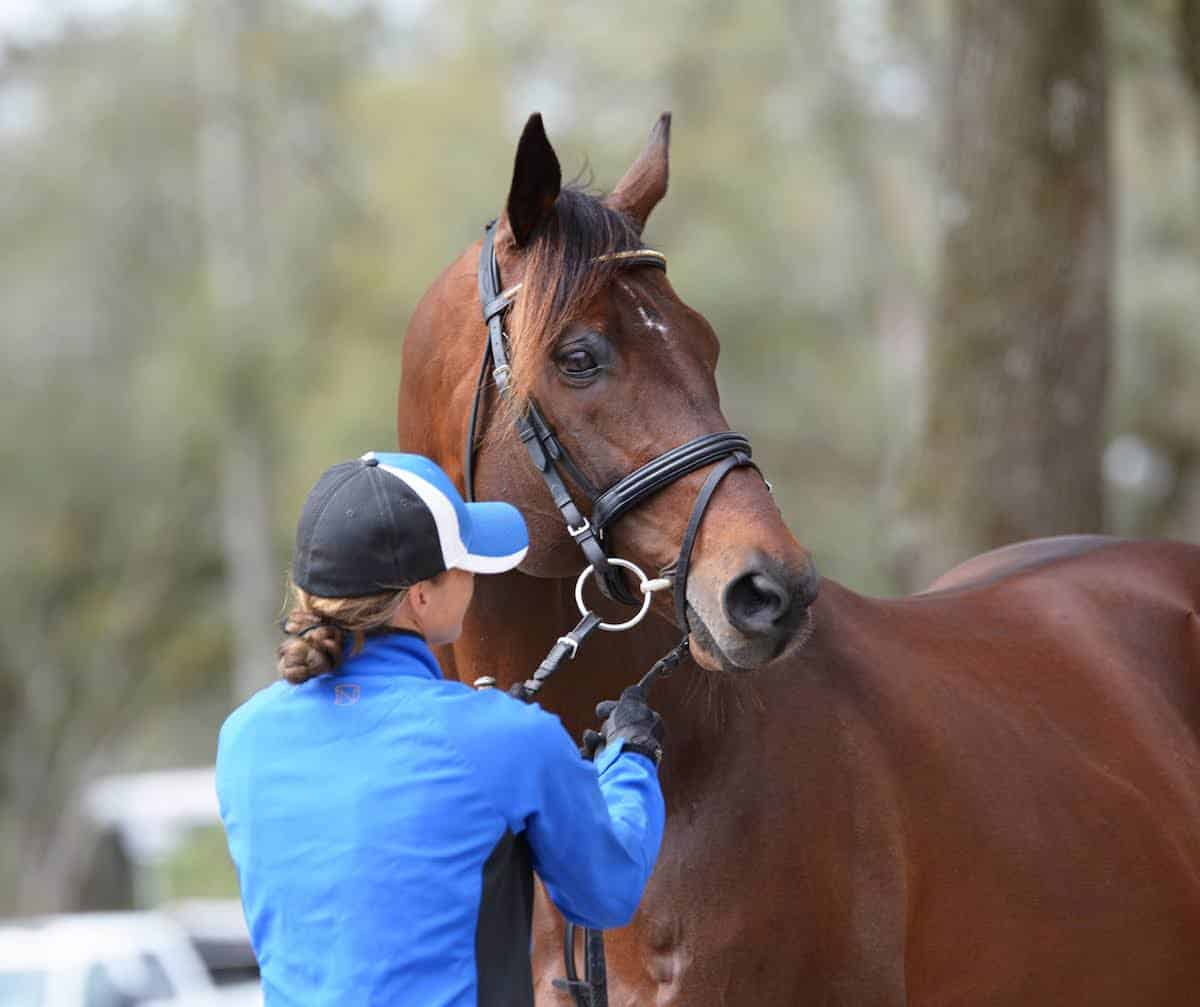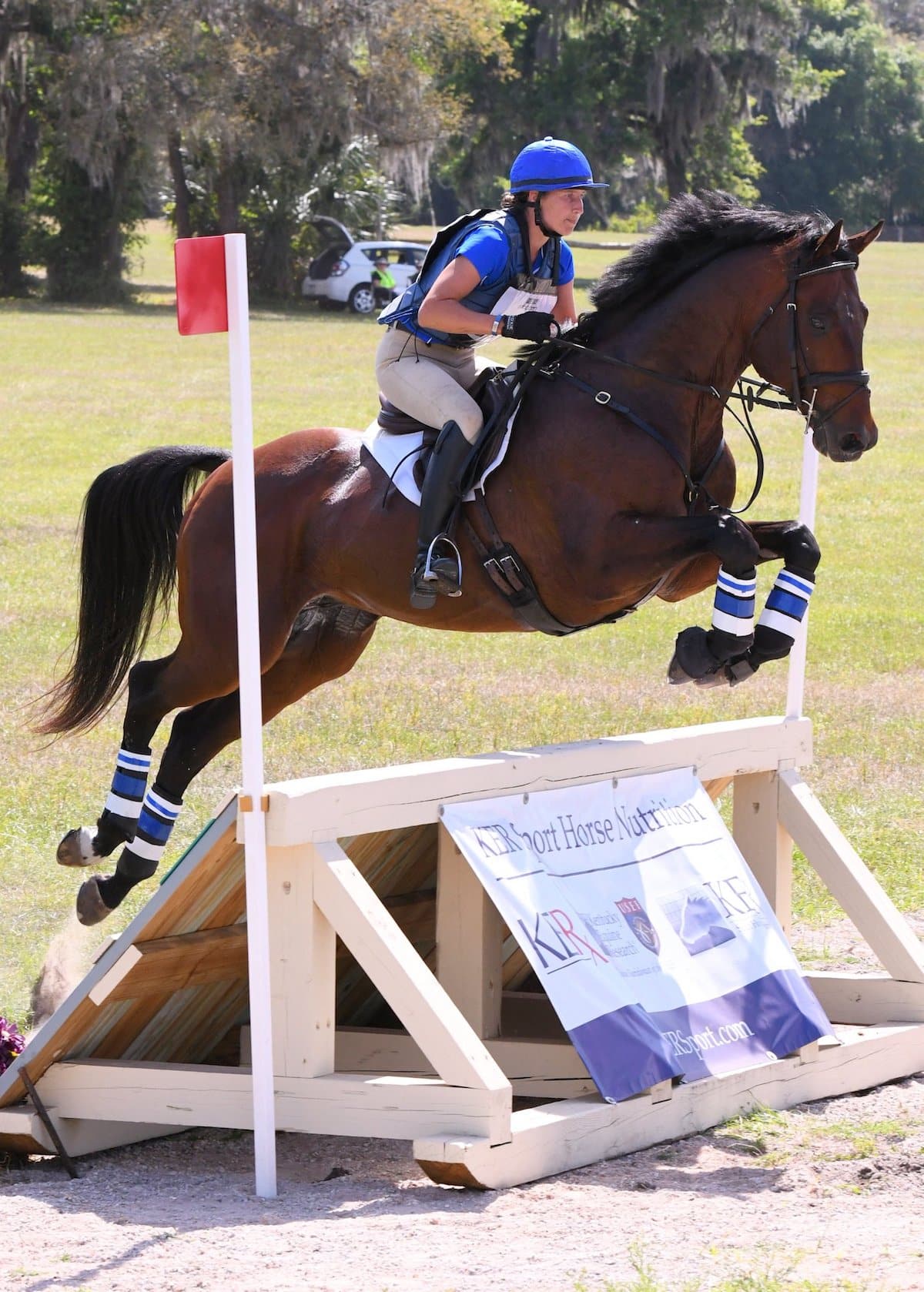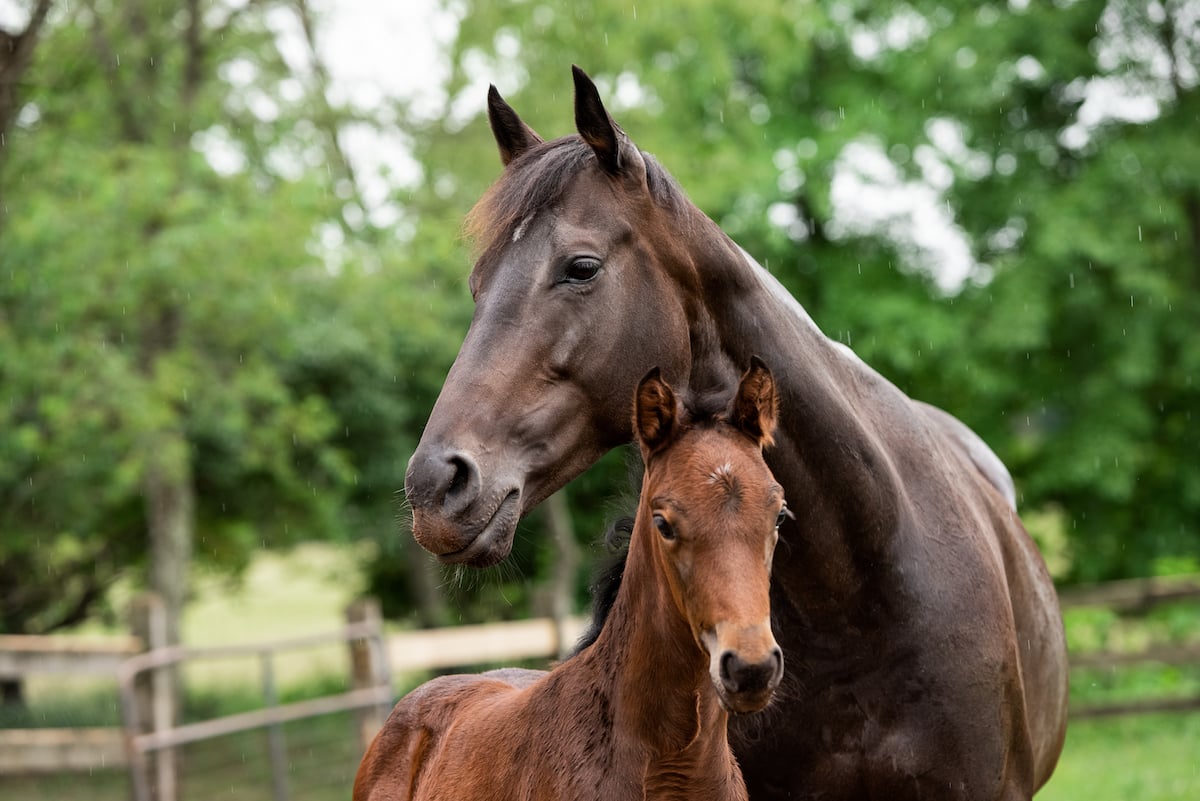Thoroughbred blood is the not-so-secret sauce that helps Warmbloods live up to their sport horse status

Audrea Dyer has been marketing her Thoroughbred (and Makeover veteran) Saketini as a sport horse breeding stallion. Ivegotyourpicture.com courtesy Audrea Dyer
An old accounting maxim says, “You can have speed or accuracy, but not both.” In other areas the trade-off is usually power vs. speed. But increasingly, today’s competition arenas demand it all — a horse that’s powerful, agile, careful and performs with speed and style, with wow.
It’s no surprise that the sport horse market leans toward Warmbloods, particularly when it comes to dressage and show jumping. Their power and way of moving give them the edge in those competitions. But sport horse breeders recognize that when the demand is for an all-around horse who can cover ground, such as in eventing, the not-so-secret sauce they’re putting in the mix is the Thoroughbred.
The most obvious draw is the Thoroughbred stride. A horse built to cover ground naturally has a head start when courses require long gallops. But it’s not just the length or manner of the stride. Other factors are key in the Thoroughbred’s contribution to sport. Hear from three event riders and breeders what those factors are.
Gallop, Stamina, Fitness
Upper-level eventer Katie Ruppel, who is based in Ocala, Florida, believes Thoroughbred blood is a crucial component of an event horse. “Eventing is a unique sport that requires a radically varied skill set from both horse and rider,” she says. “In my opinion, the Thoroughbred will always be the base of most successful event horses. For me, this means that they are more than 50% (Thoroughbred).
“The cross-country phase requires stamina, endurance and also lightness across the ground, which comes from an economical galloping style,” she continues. “Even if a horse has perfect jumping technique, if it is too heavy or is too hard across the ground, it will wear itself out galloping. And on a big track such as (the Kentucky Three-Day), you will find yourself in a precarious situation come nine, 10 or 11 minutes,” into your ride.
Eventer and breeder Audrea Dyer, who splits her time between Ocala and Lexington, Kentucky, agrees. She restarted her Thoroughbred stallion Saketini (Bernardini — Mining My Business, Mining) off the track, finished 10th in Eventing at the 2016 Thoroughbred Makeover and has since competed him through Preliminary. “For eventing, you need the Thoroughbred gallop, stamina and fitness,” she says. “It’s hard to get the heavier horses fit enough for the big track. I’ve watched many European imports competing down here in Florida. The Warmbloods’ feet hit the ground really hard, and their breathing is noisy, compared to Thoroughbreds. We are talking fit horses ridden by top people who are not slack on fitness, but it’s still work for them.
“For cross-country,” she continues, “Thoroughbreds have an advantage in that they’re able to be fit with less pounding, fewer miles. So they might actually stay sounder in the long run because you’re not having to do as many trot sets to get the fitness on them.”
Talk with any advanced event rider, and they’ll tell you that on long, grueling courses, Thoroughbred stamina and try is an asset they don’t want to be without.
All-Important Work Ethic

Audrea Dyer says some breeders have chosen to pair their Warmblood mares with Saketini to give them a bit more engine. Xpress Foto, courtesy Audrea Dyer
That try, often called “heart,” is another trait — and maybe the most important one — Warmblood breeders are adding to their programs.
Well-known veteran eventer and extraordinary horseman Denny Emerson (the only rider to have won both an Olympic gold medal in eventing and a Tevis buckle in endurance) once explained on his Facebook page why he likes Thoroughbreds in eventing:
“The biggest reason — You’re galloping along on course. It is a hot day. It is a long course. It is hilly. It has rained, and the footing is deep in places. The jumps are tough. Everything is conspiring to suck the heart and drive out of the horse.
“You cluck to the horse and ask for more gas. BAM. Like a stock car at a speedway, the horse slams you in the seat with the cantle of the saddle and propels you into the next gear.
“Other horses may bring different gifts, but the Thoroughbred brings the go button. The ‘Yes, I will’ response. The heart bred in by centuries of racing, eye to eye, to see which one will yield, which one will dominate. You can’t recreate that in 50 years. That took several hundred breeding years to install, deep deep down, where talent and willpower intersect.”
Dyer knows all about that “Yes, I will” button. “I feel like for eventing especially, you really can’t have enough Thoroughbred blood. Of course, I’m speaking as a breeder, but even with some of the Warmbloods I’ve ridden or had in training, they lack a general motivation to go forward. They’re a little bit lazy in comparison to my Thoroughbreds, who come eager to work every day.”
Her neighbor decided to breed her Warmblood mares to Saketini last year after watching Dyer ride. “My horses came out with their ears up every single day,” says Dyer. “Happy to go forward, jumping, dressage, whatever was on the menu for the day, they were eager to work, always forward and pleasant to ride.
“I was helping her ride her Warmbloods, and she was riding them as well. She would get frustrated that they didn’t come out self-starting, or they’d look for easy ways out of work or just need more of a kick ride. Her horses were selected for talent, size, substance — for jumping, for dressage movement — but not necessarily for heart. She wanted to give her horses a little more engine.”
It was to preserve that good Thoroughbred heart while adding something extra that led Karin Belgrave, of Hopewell, New Jersey, to breed her 2018 Makeover mare, Tiyo (Gio Ponti — Yo Ali, Quiet American), to a Warmblood stallion.
No stranger to riding big tracks, Belgrave competed in the 1994 Rolex Kentucky CCI*** with a big gray Thoroughbred-Hanoverian named Ben Nevis. After years away from riding, she mentioned to a racetrack trainer that she was ready return to the saddle and was looking for a unicorn with both talent and temperament. Tiyo was ready for a new career, and Belgrave scooped her up.
“She is quite literally one of the nicest horses I’ve ever had the privilege of swinging a leg over,” she says. “She’s my buckle hack, the fearless leader of most groups and the willing participant in all of my amateur whims — from cantering the hills of the Kentucky Horse Park to riding bridleless at home to jumping around whatever the last person left in the ring.
“I wanted a succession plan for her because, while she’s sound now, I know she won’t stay sound forever, given her old racing injuries and foot problems. I wanted a little piece of her that could be my next really nice horse project.”
So Belgrave selected a Dutch Warmblood as the sire, hoping to get more elasticity of movement and a more substantial foot. “She has a wonderful temperament, but I wanted to breed her to a horse also known for good temperament,” she explains. “Sir Sinclair, Keur of Iron Spring Farm is in his 20s and known for throwing good, solid citizen upper-level horses, mostly dressage, but also amateur horses. He’s really proven. And we have a baby! A perfect filly born on Mother’s Day. Tiyo is a great momma, and it’s like a dream come true.”
Deliberate Breeding Decisions

Karin Belgrave bred her her 2018 Makeover mare, Tiyo, to a Dutch stallion to produce “Rio.” She wanted to blend the Warmblood movement with the Thoroughbred talent and temperament. Courtesy Karin Belgrave
Ruppel believes you can use the Thoroughbred nature and temperament to create an ideal equine athlete. “In my own breeding program, I work toward every foal being ¾ to 7/8 Thoroughbred, mostly because I enjoy the mind of a Thoroughbred,” she says. “They are pleasers and triers. Most of the time they are working with you, not against you.
“Thoroughbreds have been bred to run, so if we’re talking about breeding for a sport such as eventing that also requires a scopey mover and jumper, there are areas of the breed that can be improved upon with the addition of warm or cold blood.”
Ruppel says she gravitates toward jumper-bred Warmblood stallions when selecting pairings for her Thoroughbred mares. “Removing the dressage coefficient several years ago was a total game-changer in eventing — clear, fast jumping rounds are now absolutely necessary to win,” she says. “That has sparked the renaissance of Thoroughbred blood in a sport that was drifting farther and farther away from its roots.
“Sport horse breeding programs are well-established overseas, with successful and proven lineages going back many generations,” she adds. “We tap into these lines by purchasing and importing, but as a country we are playing catch-up to breed and produce our own top horses in-house. Fortunately, there is a growing number of U.S.-based breeders who are solely interested in breeding the best event horses, whereas five or 10 years ago there were just a few. Breeders are making intelligent choices when matching mares and stallions. They are really doing their research to see how the top horses are bred.”
Belgrave agrees breeders are being increasingly intentional in their matchmaking. “Eventing back in the day was so much about speed and endurance,” she says. “Since they’ve taken out the roads and tracks and steeplechase, it’s become much more important to have a horse do well in the dressage and also be a quality jumper. So people are looking toward not only Warmbloods but also the Irish horse to give some substance and the movement and kind of elasticity to really succeed in the dressage ring.”
Maybe the pundits were wrong, and you can have the best of both worlds. Add Thoroughbred spice and heart to the substance and movement of a Warmblood or Warmblood movement to the work ethic of a Thoroughbred, and you have a winning recipe.

